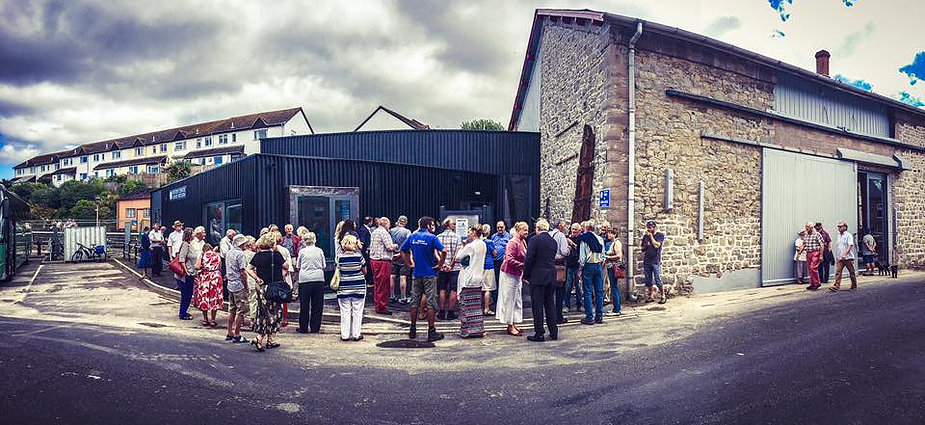Naomi Griffith is taking part in our Community Business Leadership Programme; a partnership between Power to Change, RIO and Sheffield University Management School. This support programme for community business leaders combines leadership training and expertise with fast-track connections to experts and industries. Here she, alongside Georgie Grant, both Directors of Onion Collective in Watchect, Somerset, give us an insight into what really happens when a community comes together to imagine the future of their town.
Last month, Watchet in Somerset opened a newly restored Boat Museum with attached Visitor Centre. It is part of an on-going community development project to help make a small rural town resilient and future proofed and is part of a series of new capital build projects planned for the town. The project is led by social enterprise Onion Collective CIC, an organisation working for community-led regeneration. The boat museum and associated land was transferred to the community by the local district council by Community Asset Transfer. The build was grant funded, and the internal structure of the museum was built by volunteers.

We set up Onion Collective 3 years ago, with a central aim of creating public space and facilities that benefited the town and its townsfolk rather than witnessing more development for commercial gain. Plans for a major development of flats on the marina quayside had just fallen through, and we realised that by pooling our skills and resources we could help empower our community to make the decisions about what developments take place within our town ourselves. The process we have been through, of asking and then doing, anyone can go through. It has made us never want to do anything else; the extraordinary sense of community togetherness and of achieving despite the odds has been truly life-changing.
Here are our 15 steps
1.Get angry. Preferably in a pub with friends, gesticulate and say ‘and another thing..!’ a lot and accidentally buy too many rounds of cider. Repeat this step until it becomes unbearable; decide to do something about it! Collect like-minded people, preferably with transferable skills like law, architecture, accountancy, fund raising etc. but failing that ‘grafters’ who’s company you enjoy and who are willing to get stuck in, and set up a community business.
2. Put your collected expertise into gear and apply for funding to begin your venture. It sounds daunting but it is out there.
3. Hold as many workshops as humanly possible to work out what people want and need, and what the overall shared priorities are. Use questionnaires, videos, comment cards, school fetes and everything you can conceive of to ask as many people as possible the thing you want to know
4.Hold 32,897 meetings because you love them, while simultaneously business planning to make sure your venture can be viable even in a recession or in five consecutive years of rain.
5. Deal with sulking husband, ill children and a lost dog.
6.Find champions for your plan who are going to speak more eloquently and charmingly and irresistibly about these plans than you could ever hope to.
7.Realise that Council negotiations about Community Asset Transferare more complicated and difficult that you could have ever imagined, find solutions for them. Win the Council over, you cannot proceed without their support.
8.Put all your work: support from landowners, business planning, beautiful architect’s drawings, costings and financial forecasts into the most kick ass funding bid ever imagined. Win funding.Hold a very large party and indulge in robot dancing (you’ve earned it!)
9.Begin the real process of community collaboration, accept that it is long and painful and that lots of people are just really very…’challenging’, that’s OK this is their town too. Sentences like ‘I don’t think we can make this decision yet, we need another meeting to decide when we will have the meeting to decide the thing’ are a common occurrence.
10.Agree final plans, get planning permission, hire builders and other professionals, sort out contracts and accounts. Watch the fencing and the site office start and the bulldozers appear, feel the adrenaline flow with the feeling that it is finally REAL. Freak out a little bit.
11.Discover Something Bad that means an extra £20k you hadn’t budgeted for, feel a bit sick, go back to the drawing board and work it out, it will be OK.
12.Say a little prayer of thanks to the genuinely wonderful, inspiring volunteers who have been there, working at 7am on a Sunday again, 4th week in a row in order to be ready in time, make them tea, bring them food, make them feel good. You are nothing without them.
13.Understand that there will be haters, but often they just want to be heard. Think of things people might hate, have your answers ready, be prepared to listen and understand, more often than not if they are (really) listened to they will leave happier than when they arrived.
14.Hire staff, send out launch invites, do radio interviews, and build a website. Embrace your large group of extraordinary co-workers who are there, for the most part for free. Because they want the same things you want, because they believe in the same thing you do. Feel ridiculously proud.
15.Open the doors, welcome people in and realise you are only just beginning.
Sound easy? Perhaps not, but our community did it all! In the month since it opened the Boat Museum has had 4,000 visitors – the same amount it used to receive annually. When the town came together to ask ‘what does Watchet need for a stronger future?’ it called for a stronger tourism offer and a better celebration of the local maritime heritage – The Boat Museum is certainly answering those calls and is a shining example of what community-led regeneration can achieve.
Naomi Griffith is taking part in our Community Business Leaders Programme.
Find out more about Onion Collective and their community led work @onioncollective
